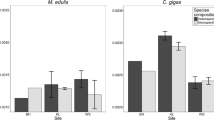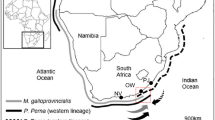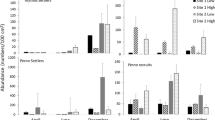Abstract
On the south coast of South Africa, the invasive alien mussel Mytilus galloprovincialis shows partial habitat segregation with the indigenous mussel Perna perna. P. perna predominates in the lower mussel zone and M. galloprovincialis in the upper zone, with mixed beds where the two overlap. We examined competitive interactions between these species by translocating mussels into small plots at high densities. Treatments involved different combinations of species and densities placed in each zone. Mortality was monitored regularly and at the end of each experiment, growth and condition index were measured. The experiment was attempted three times. The first two attempts were disrupted by wave action, especially winter storms, but provided information on species-specific effects of wave action. In experiment one, wave induced mortality decreased from a mean for both species of approximately 90% on the low shore to ca. 50% on the high shore, and was 15–30% lower for P. perna than M. galloprovincialis in each zone. In experiment two, M. galloprovincialis mortality was not affected by zone (Kruskal–Wallis test, P > 0.05), but was higher than P. perna mortality in the low zone (P < 0.05). P. perna survival was significantly (P < 0.05) lower on the high than mid and low zones, apparently due to the effects of greater emersion. Condition index showed a similar pattern, being lowest in the low zone for M. galloprovincialis and in the high zone for P. perna (3-way ANOVA, P < 0.05). Growth rates were fastest for both species in the low zone (Kruskal–Wallis, P < 0.05 in both cases). The third experiment was run for 12 months in the low zone only and provided evidence of intraspecific competition for P. perna and of interspecific competition. Condition was significantly greater for P. perna in all treatments (2-way ANOVA), as was growth (Kruskal–Wallis P < 0.05). Significant treatment effects indicated that P. perna had a negative effect on M. galloprovincialis survival (Kruskal–Wallis, P < 0.05). Again wave action was important; by the end of the experiment all mussels had been removed from plots stocked only with M. galloprovincialis. Thus P. perna improves survival of M. galloprovincialis on the low shore in the short term, by providing protection against wave action, but excludes it competitively in the longer term. The results show that partial habitat segregation is likely to be a permanent feature on the south coast, with M. galloprovincialis unable to dominate the low shore due to the effects of waves and competitive exclusion by P. perna. This study is the first attempt to examine the mechanisms of interaction between invasive and indigenous marine mussel species and provides evidence of the importance of environmental conditions in the mediation of this interaction.





Similar content being viewed by others
References
Anderson AS, Bilodeau AL, Gilg MR, Hilbish TJ (2002) Routes of introduction of the Mediterranean mussel (Mytilus galloprovincialis) to Puget Sound and Hood Canal. J Shellfish Res 21:75–79
Bownes SJ (2005) Habitat segregation in competing species of intertidal mussels in South Africa. PhD thesis, Rhodes University
Branch GM (1975) Intraspecific competition in Patella cochlear Born. J Anim Ecol 44:263–282
Branch GM (1984) Competition between marine organisms: ecological and evolutionary implications. Oceanogr Mar Biol Annu Rev 22:429–593
Branch GM, Steffani CN (2004) Can we predict the effects of alien species? A case-history of the invasion of South Africa by Mytilus galloprovincialis (Lamarck). J Exp Mar Biol Ecol 300:189–215
Brundrit GB, Shannon LV (1989) Cape storms and the Agulhas current: a glimpse of the future? S Afr J Mar Sci 85:619–620
Calvo-Ugarteburu G, McQuaid CD (1998) Parasitism and invasive species: effects of digenetic trematodes on mussels. Mar Ecol Prog Ser 169:149–163
Carlton JT (1996) Pattern, process, and prediction in marine invasion ecology. Biol Conserv 78:97–106
Connell JH (1961) The influence of interspecific competition and other factors on the distribution of the barnacle Chthamalus stellatus. Ecology 42:710–723
Connell JH (1978) Diversity in tropical rain forests and coral reefs. Science 199:1302–1310
Connolly SR, Roughgarden J (1999) Theory of marine communities: competition, predation, and recruitment–dependent interaction strength. Ecol Monogr 69:277–296
De Moor IJ, Bruton MN (1988) Atlas of alien and translocated indigenous aquatic animals in southern Africa. South African national scientific programmes report, Pretoria, 144: 1–310
Denny M (1995) Predicting physical disturbance: mechanistic approaches to the study of survivorship on wave-swept shores. Ecol Monogr 65:371–418
Dye AH, Dyantyi N (2002) Reseeding of mussels on denuded rocky shores: preliminary studies with the Brown mussel Perna perna. S Afr J Mar Sci 24:65–70
van Erkom Schurink C, Griffiths CL (1993) Factors affecting relative growth in four South African mussel species. Aquaculture 109:257–273
Griffiths CL, Hockey PAR (1987) A model describing the interactive roles of predation, competition and tidal elevation in structuring mussel populations. S Afr J Mar Sci 5:547–556
Griffiths CL, Hockey PAR, van Erkom Schurink C, Le Roux PJ (1992) Marine invasive aliens on South African shores: implications for community structure and trophic functioning. S Afr J Mar Sci 12:713–722
Grosholz E (2002) Ecological and evolutionary consequences of coastal invasions. Trends Ecol Evol 17:22–27
Harger JR (1968) The role of behavioral traits in influencing the distribution of two species of sea mussel, Mytilus edulis and Mytilus californianus. Veliger 11:45–49
Harger JR, Landenberger DE (1971) The effects of storms as a density dependent mortality factor on populations of sea mussels. Veliger 14:195–210
Hicks DW, Tunnell JW, McMahon RF (2001) Population dynamics of the nonindigenous Brown mussel Perna perna in the Gulf of Mexico compared to other world-wide populations. Mar Ecol Prog Ser 211:181–192
Hill MS (1998) Spongivory on Caribbean reefs releases corals from competition with sponges. Oecologia 117:143–150
Hockey PAR, Bosman AL (1986) Man as an intertidal predator in Transkei: disturbance, community convergence and management of a natural food resource. Oikos 46:3–14
Hockey PAR, van Erkom Schurink C (1992) The invasive biology of the mussel Mytilus galloprovincialis on the southern African coast. Trans R Soc S Afr 48:123–139
King PA, McGrath D, Britton W (1990) The use of artificial substrates in monitoring mussel (Mytilus edulis L.) settlement on an exposed rocky shore in the west of Ireland. J Mar Biol Assoc UK 70:371–380
Lee SY, Morton BS (1985) The introduction of the Mediterranean mussel Mytilus galloprovincialis into Hong Kong. Malacol Rev 18:107–109
Lubchenco J (1980) Algal zonation in the New England rocky intertidal community: an experimental analysis. Ecology 61:333–344
Mack RN, Simberloff D, Lonsdale WM, Evans H, Clout M, Bazzaz FA (2000) Biotic invasions: causes, epidemiology, global consequences, and control. Ecol Appl 10:689–710
McGrorty S, Goss-Custard JD (1995) Population dynamics of Mytilus edulis along environmental gradients: density-dependent changes in adult mussel numbers. Mar Ecol Prog Ser 129:197–213
McQuaid CD, Lindsay TL (2000) Effect of wave exposure on growth and mortality rates of the mussel Perna perna: bottom-up regulation of intertidal populations. Mar Ecol Prog Ser 206:147–154
McQuaid CD, Phillips TE (2000) Limited wind-driven dispersal of intertidal mussel larvae: in situ evidence from the plankton and the spread of the invasive species Mytilus galloprovincialis in South Africa. Mar Ecol Prog Ser 201:211–220
Paine RT (1974) Intertidal community structure. Experimental studies on the relationship between a dominant competitor and its principal predator. Oecologia 15:93–120
Paine RT (1979) Disaster, catastrophe, and local persistence of the sea palm Postelsia palmaeformis. Science 205:685–687
Paine RT, Levin SA (1981) Intertidal landscapes: disturbance and the dynamics of pattern. Ecol Monogr 51:145–178
Phillips TE (1995) Dispersal, settlement and recruitment: their influence on the dynamics of intertidal mussels. PhD thesis, Rhodes University
Ramírez SC, Cáceres-Martínez J (1999) Settlement of the blue mussel Mytilus galloprovincialis Lamarck on artificial substrates in Bahía de Todos Santos, B.C., México. J Shellfish Res 18:33–39
Raubenheimer D, Cook P (1990) Effects of exposure to wave action on allocation of resources to shell and meat growth by the subtidal mussel, Mytilus galloprovincialis. J Shellfish Res 9:87–93
Robinson TB, Griffiths CL, McQuaid CD, Rius M (2005) Marine alien species of South Africa—status and impacts. Afr J Mar Sci 27:297–306
Ruiz Sebastián C, Steffani CN, Branch GM (2002) Homing and movement patterns of a South African limpet Scutellastra argenvillei in an area invaded by an alien mussel Mytilus galloprovincialis. Mar Ecol Prog Ser 243:111–122
Seed R, Suchanek TH (1992) Population and community ecology of Mytilus. In: Gosling E (ed) The mussel Mytilus: ecology, physiology, genetics and culture. Elsevier, Amsterdam, pp 87–169
Siegfried WR, Hockey PAR, Crowe AA (1985) Exploitation and conservation of Brown mussel stocks by coastal people of Transkei. Environ Conserv 12:303–307
Sousa W (1984) Intertidal mosaics: patch size, propagule availability and spatially variable patterns of succession. Ecology 65:1918–1935
Steffani CN, Branch GM (2003a) Spatial comparisons of populations of an indigenous limpet Scutellastra argenvillei and an alien mussel Mytilus galloprovincialis along a gradient of wave energy. Afr J Mar Sci 25:195–212
Steffani CN, Branch GM (2003b) Temporal changes in an interaction between an indigenous limpet Scutellastra argenvillei and an alien mussel Mytilus galloprovincialis: effects of wave exposure. Afr J Mar Sci 25:213–229
Steffani CN, Branch GM (2003c) Growth rate, condition, and shell shape of Mytilus galloprovincialis: responses to wave exposure. Mar Ecol Prog Ser 246:197–209
Underwood AJ (1976) Food competition between age-classes in the intertidal neritacean Nerita atramentosa Reeve (Gastropoda: Prosobranchia). J Exp Mar Biol Ecol 23:145–154
Underwood AJ (1986) The analysis of competition by field experiments. In: Kikkawa J, Anderson DJ (eds) Community ecology: pattern and process. Blackwell, Melbourne, pp 240–268
Vakily JM (1989) The biology and culture of mussels of the genus Perna. ICLARM Stud Rev 17:1–63
Williamson M (1996) Biological invasions. Chapman and Hall, London
Zar JH (1984) Biostatistical analysis. Prentice Hall, New Jersey
Zardi GI, Nicastro KR, McQuaid CD, Rius M, Porri F (2006) Hydrodynamic stress and habitat partitioning between indigenous (Perna perna) and invasive (Mytilus galloprovincialis) mussels: constraints of an evolutionary strategy. Mar Biol (in press)
Acknowledgments
This work was supported by a “beca MAE-AECI” to M. R. from the Spanish “Ministerio de Asuntos Exteriores” and by funding from the National Research Foundation and Marine and Coastal Management in South Africa. We would like to thank S. Bownes, E. Díaz, J. Hill, M. Hlongwane, J. Lukey, F. Porri and G. Zardi for assistance in the fieldwork. The experiments described in this paper comply with the current South African laws.
Author information
Authors and Affiliations
Corresponding author
Additional information
Communicated by G.F. Humphrey, Sydney
Rights and permissions
About this article
Cite this article
Rius, M., McQuaid, C.D. Wave action and competitive interaction between the invasive mussel Mytilus galloprovincialis and the indigenous Perna perna in South Africa. Mar Biol 150, 69–78 (2006). https://doi.org/10.1007/s00227-006-0322-4
Received:
Accepted:
Published:
Issue Date:
DOI: https://doi.org/10.1007/s00227-006-0322-4




